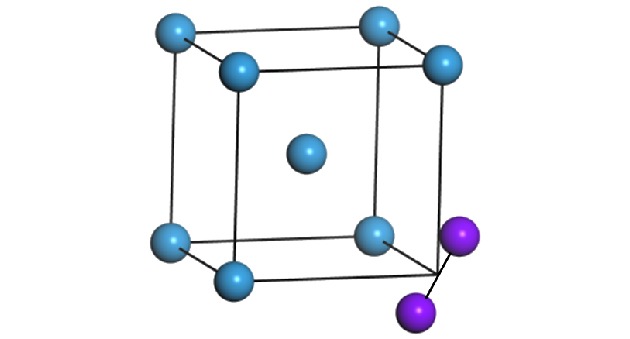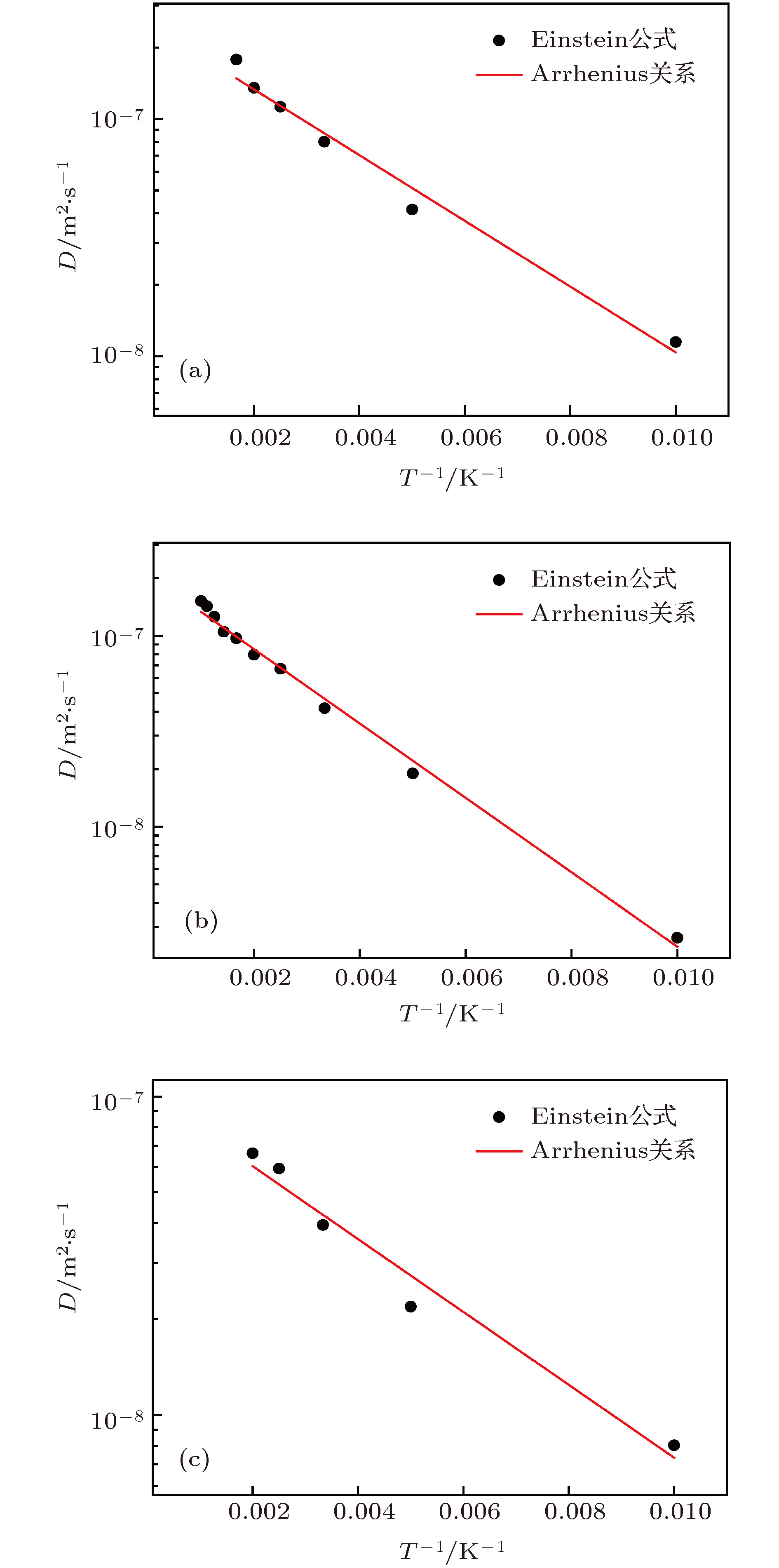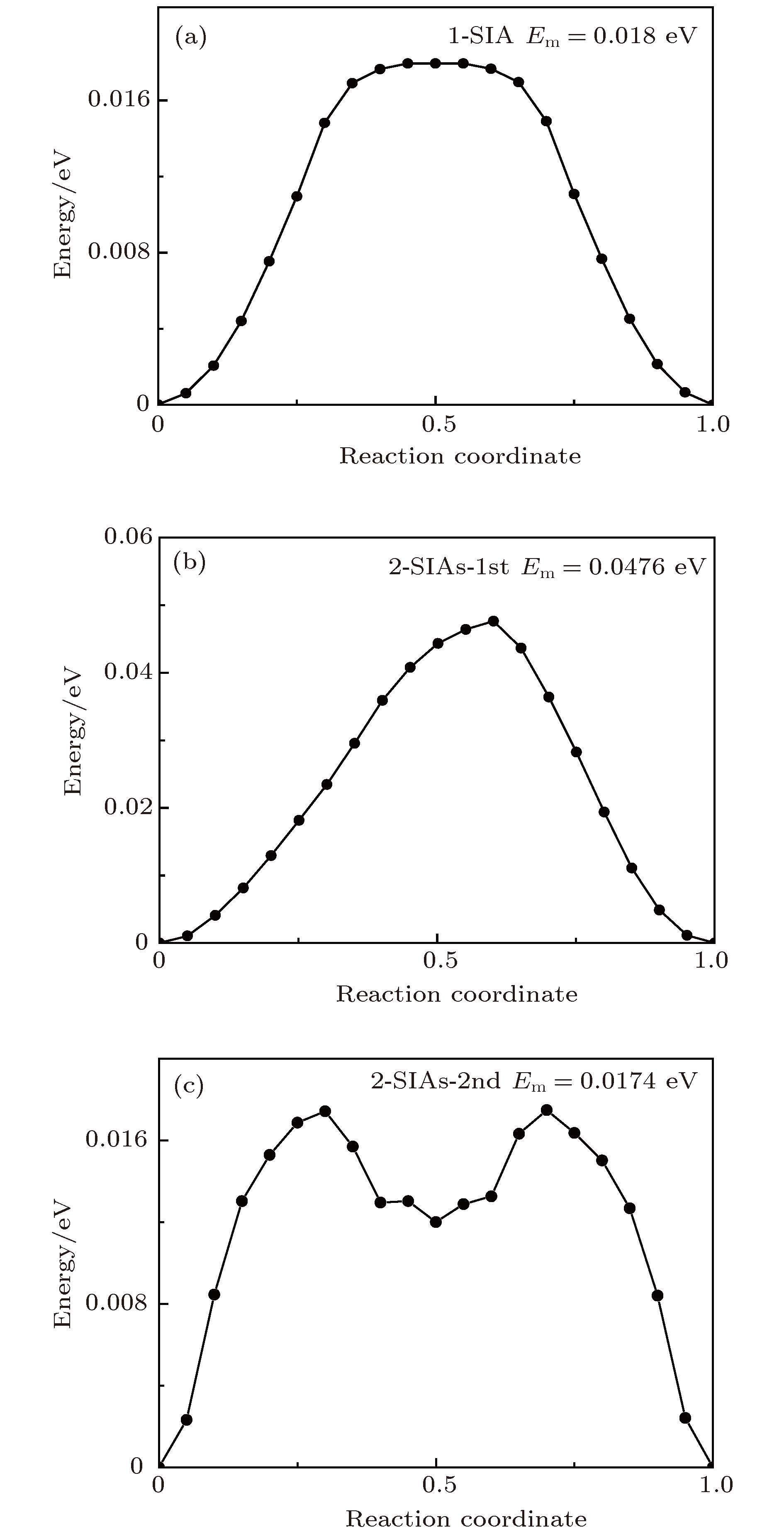-
Tungsten, due to its desirable properties (high melting point, low sputtering coefficient, good irradiation resistance etc.), is considered as a promising candidate for the plasma facing materials in future nuclear fusion reactors. Therefore, it will work in extremely harsh environments because it is subjected to the bombadement of high-flux plasma particles and the irradiation of high energy neutrons, resulting in vacancies and interstitials. The migration behavior of self-interstitial atoms is one of the most important factors determining the microstructure evolution in irradiated metals because it will greatly affect the mechanical properties of materials. The study of the diffusion behavior of di-interstitials with different configurations contributes to a better understanding of the self-interstitial atom behavior in tungsten. Despite the inherent difficulty in experimental approaches, atomistic simulation provides an effective means of investigating the defect evolution in materials. In this paper, based on the newly developed interatomic potential for W-W interaction, the diffusion behavior of self-interstitial atoms in tungsten is studied by molecular dynamics simulation. This work focuses on the investigation of the diffusion behavior of di-interstitials with different configurations at different temperatures. The obtained results show that the di-interstitials with the first nearest neighbor configuration presents the one-dimensional migration in the
$\left\langle 111 \right\rangle $ direction at temperatures below 1400 K. As the temperature increases, it makes rotations from one$ \left\langle 111 \right\rangle$ - to other$\left\langle 111 \right\rangle $ -directions. Thus migration of di-interstitial atoms with the first nearest neighbor configuration exhibits a change in mechanism from one-dimensional to three-dimensional migration, keeping the stable$\left\langle 111 \right\rangle $ configuration in the whole investigated temperature range. The migration of di-interstitial atoms with the second nearest neighbor configuration is one-dimensional along the$\left\langle 111 \right\rangle$ direction within a certain temperature range. When the temperature is above 600 K, the di-interstitial atoms will dissociate into two individual self-interstitial atoms and move independently. However, the migration of di-interstitial atoms with the third nearest neighbor configuration dissociates at a temperature just above 300 K. The non-parallel self-interstitial atoms form a sessile configuration within a certain temperature range. Once the sessile cluster is formed it can hardly move. Interestingly, it will transform into mobile defect when the temperature is higher than 1000 K. By comparing the migration energy values of these configurations obtained by nudged elastic band method with those of the Arrhenius fits, we find that the diffusivity for each of single- and di-interstitial atoms in tungsten is a linear function of temperature rather than Arrhenius as usually assumed.-
Keywords:
- self-interstitial atoms /
- diffusion behavior /
- irradiation damage /
- molecular dynamics simulation
[1] Chen L, Liu Y L, Zhou H B, Jin S, Zhang Y, Lu G H 2012 Sci. China: Phys. Mech. Astron. 55 614
 Google Scholar
Google Scholar
[2] 汪俊, 周宇璐, 张宝玲, 侯氢 2011 60 106601
 Google Scholar
Google Scholar
Wang J, Zhou Y L, Zhang B L, Hou Q 2011 Acta Phys. Sin. 60 106601
 Google Scholar
Google Scholar
[3] 郭洪燕, 夏敏, 燕青芝, 郭立平, 陈济红, 葛昌纯 2016 65 077803
 Google Scholar
Google Scholar
Guo H Y, Xia M, Yan Q Z, Guo L P, Chen J H, Ge C C 2016 Acta Phys. Sin. 65 077803
 Google Scholar
Google Scholar
[4] Zhou W H, Li Y G, Huang L F, Zeng Z, Ju X 2013 J. Nucl. Mater. 437 438
 Google Scholar
Google Scholar
[5] Zhou W H, Zhang C G, Li Y G, Zeng Z 2014 J. Nucl. Mater. 453 202
 Google Scholar
Google Scholar
[6] 郭龙婷, 孙继忠, 黄艳, 刘升光, 王德真 2013 62 227901
 Google Scholar
Google Scholar
Guo L T, Sun J Z, Huang Y, Liu S G, Wang D Z 2013 Acta Phys. Sin. 62 227901
 Google Scholar
Google Scholar
[7] Terentyev D A, Malerba L, Hou M 2007 Phys. Rev. B 75 104108
[8] Marinica M C, Willaime F, Mousseau N 2011 Phys. Rev. B 83 094119
 Google Scholar
Google Scholar
[9] Fu C C, Willaime F 2004 Phys. Rev. Lett. 92 175503
 Google Scholar
Google Scholar
[10] Terentyev D A, Klaver T P, Olsson P, Marinica M C, Willaime F, Domain C, Malerba L 2008 Phys Rev Lett. 100 145503
 Google Scholar
Google Scholar
[11] Derlet P M, Nguyen-Manh D, Dudarev S L 2007 Phys. Rev. B 76 054107
 Google Scholar
Google Scholar
[12] Ventelon L, Willaime F, Fu C C, Heran M, Ginoux I 2012 J. Nucl. Mater. 425 16
 Google Scholar
Google Scholar
[13] Tsong T T, Casanova R 1980 Phys. Rev. B 22 4632
 Google Scholar
Google Scholar
[14] Amino T, Arakawa K, Mori H 2016 Sci. Rep. 6 26099
 Google Scholar
Google Scholar
[15] Zhou W H, Zhang C G, Li Y G, Zeng Z 2015 Sci. Rep. 4 5096
 Google Scholar
Google Scholar
[16] Chen D, Hu W, Yang J, Deng H, Sun L, Gao F 2009 Eur. Phys. J. B 68 479
 Google Scholar
Google Scholar
[17] Dudarev S L, Ma P W 2018 Phys. Rev. Mater. 2 033602
 Google Scholar
Google Scholar
[18] Ma P W, Dudarev S L 2019 Phys. Rev. Mater. 3 013605
 Google Scholar
Google Scholar
[19] Swinburne T D, Ma P W, Dudarev S L 2017 New J. Phys. 19 073024
 Google Scholar
Google Scholar
[20] Bonny G, Terentyev D, Bakaev A, Grigorev P, van Neck D 2014 Modell. Simul. Mater. Sci. Eng. 22 053001
 Google Scholar
Google Scholar
[21] Marinica M C, Ventelon L, Gilbert M R, Proville L, Dudarev S L, Marian J, Bencteux G, Willaime F 2013 J. Phys.: Condens. Matter 25 395502
 Google Scholar
Google Scholar
[22] Wang J, Zhou Y L, Li M, Hou Q 2014 Modell. Simul. Mater. Sci. Eng. 22 257
[23] Wang J, Zhou Y L, Li M, Hou Q 2012 J. Nucl. Mater. 427 290
 Google Scholar
Google Scholar
[24] Wooding S J, Bacon D J, Phythian W J 1995 Philos. Mag. A 72 1261
 Google Scholar
Google Scholar
[25] Wooding S J, Howe L M, Gao F, Calder A F, Bacon D J 1998 J. Nucl. Mater. 254 191
 Google Scholar
Google Scholar
[26] Wooding S J, Bacon D J 1997 Philos. Mag. A 76 1033
 Google Scholar
Google Scholar
[27] Gao F, Bacon D J, Osetsky Y N, Flewitt P E J, Lewis T A 2000 J. Nucl. Mater. 276 213
 Google Scholar
Google Scholar
[28] Bacon D J, Gao F, Osetsky Yu N 2000 J. Nucl. Mater. 276 1
 Google Scholar
Google Scholar
[29] Boisvert G, Lewis L J 1996 Phys. Rev. B 54 2880
 Google Scholar
Google Scholar
[30] Swinburne T D, Dudarev S L 2015 Phys. Rev. B 92 134302
 Google Scholar
Google Scholar
[31] Jonsson H, Mills G, Jacobsen K W 1998 Classical And Quantum Dynamics In Condensed Phase Simulations (Singapore: World Scientific) pp385−404
-
图 2 2-SIAs的不同构型图 (a), (b), (c), (d)分别代表最近邻、次近邻、三近邻以及非平行结构的结构示意图; 右上方的插图分别代表这几种结构
$ \left\langle 111 \right\rangle$ 方向的视图; 紫色球为SIAs, 蓝色球为格点原子Figure 2. Schematic illustrations of the 2-SIAs with different configurations: (a), (b), (c), (d) Represent the configuration of the 2-SIAs-1st, 2-SIAs-2nd, 2-SIAs-3rd and the non-parallel SIAs, respectively. Insets represent the views corresponding to their
$ \left\langle 111 \right\rangle$ orientations; the purple sphere stands for the SIA and the blue one stands for the lattice atom.图 6 不同结构的扩散系数(图中实线是根据Arrhenius关系拟合的结果) (a) 1-SIA; (b) 2-SIAs-1st; (c) 2-SIAs-2nd
Figure 6. Arrhenius plots of diffusion coefficients of single SIA and di-interstitial atoms in tungsten, which is determined using MD simulations and plotted as a function of the absolute temperature T: (a) 1-SIA; (b) 2-SIAs-1st; (c) 2-SIAs-2nd.
表 1 不同缺陷结构的形成能
Table 1. Formation energies of self-interstitials with different configurations.
缺陷类型 能量/eV 1SIA 10.406 2-SIAs-1st 18.574 2-SIAs-2nd 20.510 2-SIAs-3rd 20.808 sessile cluster 19.330 表 2 不同缺陷结构的束缚能
Table 2. Binding energies of self-interstitials with different configurations.
缺陷类型 能量/eV 2-SIAs-1st 2.245 2-SIAs-2nd 0.309 2-SIAs-3rd 0.012 sessile cluster 1.489 表 3 Arrhenius拟合所得各个间隙结构的扩散迁移能与前因子
Table 3. Migration energy Em (in eV) and prefactor D0 (in cm2/s) for W clusters diffusion obtained by Arrhenius fitting.
缺陷结构 迁移能${E_{\rm{m}}}/{\rm{eV}}$(Arrhenius) 前因子D0/m2·s–1 迁移能${E_{\rm{m}}}/{\rm{eV}}$ (NEB) 1-SIA 0.0274 2.52 × 10–7 0.0180 2-SIAs-1st 0.0386 2.08 × 10–7 0.0476 2-SIAs-2nd 0.0248 1.02 × 10–7 0.0174 -
[1] Chen L, Liu Y L, Zhou H B, Jin S, Zhang Y, Lu G H 2012 Sci. China: Phys. Mech. Astron. 55 614
 Google Scholar
Google Scholar
[2] 汪俊, 周宇璐, 张宝玲, 侯氢 2011 60 106601
 Google Scholar
Google Scholar
Wang J, Zhou Y L, Zhang B L, Hou Q 2011 Acta Phys. Sin. 60 106601
 Google Scholar
Google Scholar
[3] 郭洪燕, 夏敏, 燕青芝, 郭立平, 陈济红, 葛昌纯 2016 65 077803
 Google Scholar
Google Scholar
Guo H Y, Xia M, Yan Q Z, Guo L P, Chen J H, Ge C C 2016 Acta Phys. Sin. 65 077803
 Google Scholar
Google Scholar
[4] Zhou W H, Li Y G, Huang L F, Zeng Z, Ju X 2013 J. Nucl. Mater. 437 438
 Google Scholar
Google Scholar
[5] Zhou W H, Zhang C G, Li Y G, Zeng Z 2014 J. Nucl. Mater. 453 202
 Google Scholar
Google Scholar
[6] 郭龙婷, 孙继忠, 黄艳, 刘升光, 王德真 2013 62 227901
 Google Scholar
Google Scholar
Guo L T, Sun J Z, Huang Y, Liu S G, Wang D Z 2013 Acta Phys. Sin. 62 227901
 Google Scholar
Google Scholar
[7] Terentyev D A, Malerba L, Hou M 2007 Phys. Rev. B 75 104108
[8] Marinica M C, Willaime F, Mousseau N 2011 Phys. Rev. B 83 094119
 Google Scholar
Google Scholar
[9] Fu C C, Willaime F 2004 Phys. Rev. Lett. 92 175503
 Google Scholar
Google Scholar
[10] Terentyev D A, Klaver T P, Olsson P, Marinica M C, Willaime F, Domain C, Malerba L 2008 Phys Rev Lett. 100 145503
 Google Scholar
Google Scholar
[11] Derlet P M, Nguyen-Manh D, Dudarev S L 2007 Phys. Rev. B 76 054107
 Google Scholar
Google Scholar
[12] Ventelon L, Willaime F, Fu C C, Heran M, Ginoux I 2012 J. Nucl. Mater. 425 16
 Google Scholar
Google Scholar
[13] Tsong T T, Casanova R 1980 Phys. Rev. B 22 4632
 Google Scholar
Google Scholar
[14] Amino T, Arakawa K, Mori H 2016 Sci. Rep. 6 26099
 Google Scholar
Google Scholar
[15] Zhou W H, Zhang C G, Li Y G, Zeng Z 2015 Sci. Rep. 4 5096
 Google Scholar
Google Scholar
[16] Chen D, Hu W, Yang J, Deng H, Sun L, Gao F 2009 Eur. Phys. J. B 68 479
 Google Scholar
Google Scholar
[17] Dudarev S L, Ma P W 2018 Phys. Rev. Mater. 2 033602
 Google Scholar
Google Scholar
[18] Ma P W, Dudarev S L 2019 Phys. Rev. Mater. 3 013605
 Google Scholar
Google Scholar
[19] Swinburne T D, Ma P W, Dudarev S L 2017 New J. Phys. 19 073024
 Google Scholar
Google Scholar
[20] Bonny G, Terentyev D, Bakaev A, Grigorev P, van Neck D 2014 Modell. Simul. Mater. Sci. Eng. 22 053001
 Google Scholar
Google Scholar
[21] Marinica M C, Ventelon L, Gilbert M R, Proville L, Dudarev S L, Marian J, Bencteux G, Willaime F 2013 J. Phys.: Condens. Matter 25 395502
 Google Scholar
Google Scholar
[22] Wang J, Zhou Y L, Li M, Hou Q 2014 Modell. Simul. Mater. Sci. Eng. 22 257
[23] Wang J, Zhou Y L, Li M, Hou Q 2012 J. Nucl. Mater. 427 290
 Google Scholar
Google Scholar
[24] Wooding S J, Bacon D J, Phythian W J 1995 Philos. Mag. A 72 1261
 Google Scholar
Google Scholar
[25] Wooding S J, Howe L M, Gao F, Calder A F, Bacon D J 1998 J. Nucl. Mater. 254 191
 Google Scholar
Google Scholar
[26] Wooding S J, Bacon D J 1997 Philos. Mag. A 76 1033
 Google Scholar
Google Scholar
[27] Gao F, Bacon D J, Osetsky Y N, Flewitt P E J, Lewis T A 2000 J. Nucl. Mater. 276 213
 Google Scholar
Google Scholar
[28] Bacon D J, Gao F, Osetsky Yu N 2000 J. Nucl. Mater. 276 1
 Google Scholar
Google Scholar
[29] Boisvert G, Lewis L J 1996 Phys. Rev. B 54 2880
 Google Scholar
Google Scholar
[30] Swinburne T D, Dudarev S L 2015 Phys. Rev. B 92 134302
 Google Scholar
Google Scholar
[31] Jonsson H, Mills G, Jacobsen K W 1998 Classical And Quantum Dynamics In Condensed Phase Simulations (Singapore: World Scientific) pp385−404
Catalog
Metrics
- Abstract views: 10546
- PDF Downloads: 132
- Cited By: 0


















 DownLoad:
DownLoad:












